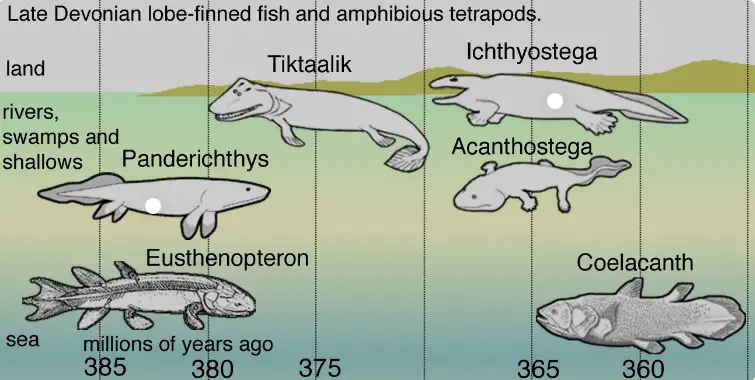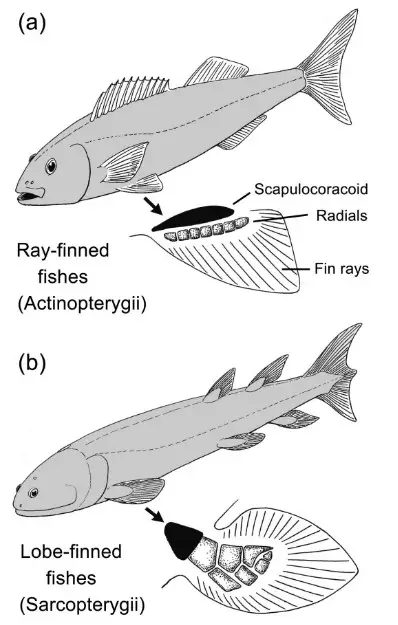The classification of fish into Sarcopterygii and Actinopterygii marks a significant divide in the evolutionary history of vertebrates. These two classes represent unique evolutionary paths, each contributing distinctively to the biodiversity of aquatic life. Their differences shed light on the complexity of evolution, adaptation, and the ecological roles they play within their respective habitats.
Sarcopterygii, or lobe-finned fishes, and Actinopterygii, commonly known as ray-finned fishes, differ primarily in fin structure, respiratory systems, and scales. Sarcopterygii are characterized by fleshy, lobed fins with a bone structure similar to the limbs of terrestrial vertebrates, offering insights into the evolution of land animals. In contrast, Actinopterygii possess fins supported by bony or horny spines, showcasing a different evolutionary strategy for aquatic life.
These classifications not only reflect anatomical and physiological differences but also highlight the diverse evolutionary strategies that have enabled fish to colonize a wide range of aquatic environments. From the depths of the oceans to the freshest of freshwater streams, Sarcopterygii and Actinopterygii demonstrate the adaptive potential of life, underpinning the rich tapestry of biodiversity that characterizes our planet’s water bodies.

Fish Classification Basics
Evolutionary Lineage
The story of fish evolution is a captivating journey that spans hundreds of millions of years, providing insight into the complexity and diversity of life on Earth. Fish are among the earliest vertebrates, with fossils dating back to the Cambrian period, approximately 530 million years ago. This vast evolutionary history has resulted in the rich variety of fish species we observe today, making them a fundamental part of the vertebrate lineage.
Introduction to Vertebrates
Vertebrates are animals distinguished by the presence of a backbone or spinal column, which includes groups such as fish, amphibians, reptiles, birds, and mammals. Fish are the most primitive group within this classification, and their study provides valuable insights into the evolution of more complex vertebrates, including humans.
Fish in the Tree of Life
In the grand scheme of evolution, fish occupy a pivotal position on the Tree of Life. They represent the transition from simple invertebrate organisms to complex vertebrate life forms. Understanding their evolutionary path helps scientists decipher the genetic and morphological changes that have shaped the evolution of all later vertebrates.
Key Definitions
What is Sarcopterygii?
Sarcopterygii, commonly known as lobe-finned fish, are a clade of vertebrates that are characterized by their unique fin structure, which resembles limbs. This group includes both living species like coelacanths and lungfish, as well as extinct relatives of these fish. Sarcopterygii are particularly noted for their role in the evolution of terrestrial vertebrates (tetrapods).
What is Actinopterygii?
Actinopterygii, known as ray-finned fish, constitute the largest class of vertebrates. Unlike their lobe-finned counterparts, ray-finned fish have fins supported by long, thin bony rays. This group encompasses the vast majority of fish species, including familiar ones like salmon, goldfish, and tuna, showcasing a remarkable diversity in form and function.
Sarcopterygii Explained
Characteristics
Fins and Limbs
The defining feature of Sarcopterygii is their lobe-finned structure, which provides a robust framework for both aquatic and, potentially, terrestrial mobility. This characteristic fin structure is believed to have been crucial in the transition of vertebrates from water to land.
Respiratory Systems
Sarcopterygii exhibit a diverse range of respiratory adaptations, including the use of lungs in lungfish, which allows them to breathe air when water oxygen levels are low. This adaptation is another critical step towards terrestrial life.
Habitat and Distribution
Lobe-finned fish are found in a variety of habitats, from deep oceanic waters to freshwater environments. However, their distribution is now largely limited due to evolutionary changes and competition with more adaptive species.
Notable Species
Coelacanths
Once thought to be extinct, coelacanths were rediscovered in 1938, providing a direct link to the fish that first ventured onto land. These living fossils are invaluable for understanding early vertebrate evolution.
Lungfish
Lungfish are remarkable for their ability to survive in drought conditions by aestivating in mud cocoons and breathing air. Their resilience and adaptations make them a key study subject in evolutionary biology.
Evolutionary Significance
The transition from aquatic to terrestrial environments by the ancestors of Sarcopterygii marks a monumental moment in the history of life on Earth. This evolutionary leap paved the way for the emergence of amphibians, reptiles, birds, and mammals.
Actinopterygii Explained
Characteristics
Fins Structure
Actinopterygii, or ray-finned fish, are characterized by their specialized fin rays, which offer precise control and efficiency in aquatic environments. This fin structure is a hallmark of their evolutionary success.
Scales and Skin
The scales and skin of ray-finned fish vary widely, reflecting the diversity of this group. From the armor-like scales of gar to the smooth skin of catfish, these adaptations protect against predators and parasites.
Breathing Mechanisms
Most Actinopterygii breathe using gills, which efficiently extract oxygen from water. This adaptation is finely tuned to their aquatic lifestyle, allowing them to inhabit a range of water conditions.
Diversity in Habitat
Actinopterygii are found in virtually all aquatic environments, from the deepest oceans to the highest mountain streams. This adaptability has led to an incredible variety of species, each suited to its niche.
Comparative Analysis
Fins and Movement
Sarcopterygii possess lobe-finned structures, which are pivotal in their movement through water. These fins, characterized by a fleshy, lobed, paired fin joined to the body by a single bone, offer a unique mechanism that supports both aquatic and, for some species, terrestrial mobility. This fin structure is considered a critical evolutionary step towards the development of limbs in terrestrial vertebrates.
In contrast, Actinopterygii, or ray-finned fishes, display fins supported by long, flexible rays. This adaptation allows for precise movements and stability in a diverse range of aquatic environments. Ray-finned fishes have mastered the art of swimming with minimal energy expenditure, showcasing an evolutionary advantage in water.
Reproduction and Lifespan
Breeding Strategies
Sarcopterygii often engage in complex breeding behaviors, with some species exhibiting parental care. Their reproductive strategies can include nest-building and guarding of eggs, which helps increase offspring survival rates.
Actinopterygii species demonstrate a wide array of reproductive strategies ranging from external fertilization in open water to more intricate behaviors such as internal fertilization and elaborate mating rituals. Their adaptability in breeding practices underpins the vast biodiversity seen within this group.
Lifespan and Growth
The lifespan and growth rates of Sarcopterygii and Actinopterygii vary significantly across species. Sarcopterygii, like the coelacanth, are known for their long lifespans, sometimes reaching several decades. This longevity is less common in Actinopterygii, although some species, like sturgeons and certain carps, can also live for many years.
Ecological Roles
Predators and Prey
Both Sarcopterygii and Actinopterygii play critical roles in their ecosystems as predators and prey. Sarcopterygii species, due to their often larger size and predatory nature, sit higher up in the food chain. Actinopterygii, with their incredible diversity, fill various niches, from top predators to vital links in the aquatic food web.
Ecosystem Impact
The ecological impact of these fish classes extends beyond their immediate food chain interactions. They contribute to the health and stability of aquatic ecosystems, affecting water quality, sediment transport, and the distribution of aquatic plants and microorganisms.
Human Interactions
Conservation Status
The conservation status of Sarcopterygii and Actinopterygii highlights the challenges faced by aquatic species. Many Sarcopterygii species are considered endangered, with habitat destruction and climate change posing significant threats. Actinopterygii, despite their vast numbers, also face pressures from overfishing, pollution, and habitat loss.
Threats to Sarcopterygii
Sarcopterygii species are particularly vulnerable due to their specific habitat requirements and low reproductive rates. The destruction of freshwater ecosystems and the impacts of global warming are critical threats that jeopardize their survival.
Actinopterygii in Fisheries
Actinopterygii species form the backbone of global fisheries, providing essential food sources for humans. However, unsustainable fishing practices have led to the decline of many fish populations, underscoring the need for responsible management and conservation efforts.
Scientific and Cultural Significance
Research Contributions
The study of Sarcopterygii and Actinopterygii has contributed significantly to our understanding of evolutionary biology, aquatic ecology, and conservation science. These classes offer insights into the adaptive mechanisms that have enabled fish to thrive for millions of years.
Cultural References
Fish have held a place in human culture for millennia, symbolizing abundance, fertility, and perseverance. The diversity and adaptability of Actinopterygii and Sarcopterygii have inspired myths, art, and literature around the world.
Future Prospects
Evolutionary Biology Insights
Continued research into the evolutionary history and adaptive strategies of Sarcopterygii and Actinopterygii promises to unveil new insights into the resilience and diversity of life on Earth. Understanding their evolutionary pathways can shed light on the potential impacts of current environmental changes.
Predicting Evolutionary Trends
By studying the evolutionary adaptations of these fish, scientists aim to predict how current species might evolve in response to ongoing environmental pressures. This knowledge is crucial for developing strategies to preserve biodiversity in the face of climate change.
Frequently Asked Questions
What are Sarcopterygii?
Sarcopterygii, or lobe-finned fishes, are a class of fish known for their unique fin structure, which resembles limbs. This group includes both living species like the coelacanth and lungfish, as well as extinct species that are ancestors of amphibians, reptiles, birds, and mammals. Their fins, which are fleshy and connected by a single bone, hint at the evolutionary transition from water to land.
How do Actinopterygii breathe?
Actinopterygii, or ray-finned fishes, breathe using gills that are protected by a bony gill cover called an operculum. Water enters the mouth, passes over the gills where oxygen is extracted, and exits behind the operculum. This efficient respiratory system supports their survival in a variety of aquatic environments, from deep oceans to shallow streams.
Why is the distinction between Sarcopterygii and Actinopterygii important?
The distinction between Sarcopterygii and Actinopterygii is crucial for understanding vertebrate evolution. It highlights two distinct evolutionary paths leading from aquatic to terrestrial life. The study of these classes provides insight into the anatomical and physiological adaptations that have allowed vertebrates to thrive in diverse environments, shaping the course of evolutionary history.
How are Sarcopterygii and Actinopterygii conserved?
Conservation efforts for Sarcopterygii and Actinopterygii involve habitat protection, pollution control, and sustainable fishing practices. Given their ecological importance and evolutionary significance, preserving their habitats is crucial. Initiatives include establishing marine protected areas, regulating fishing to prevent overexploitation, and monitoring water quality to protect against pollution.
Conclusion
The exploration of Sarcopterygii and Actinopterygii unveils the fascinating diversity of life forms and evolutionary strategies within the aquatic world. These two fish classes not only exemplify the splendor of natural selection but also underscore the importance of conserving aquatic ecosystems. Their distinct evolutionary paths remind us of the complex interplay between adaptation and environment that has shaped the rich biodiversity of our planet.
In conclusion, understanding the differences between Sarcopterygii and Actinopterygii enriches our appreciation of the natural world and its evolutionary marvels. It serves as a call to action for the conservation of aquatic life, urging us to protect the delicate balance that sustains the diversity of life on Earth.

